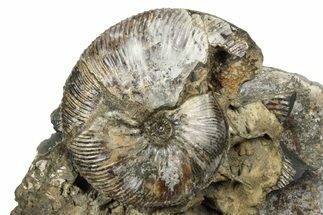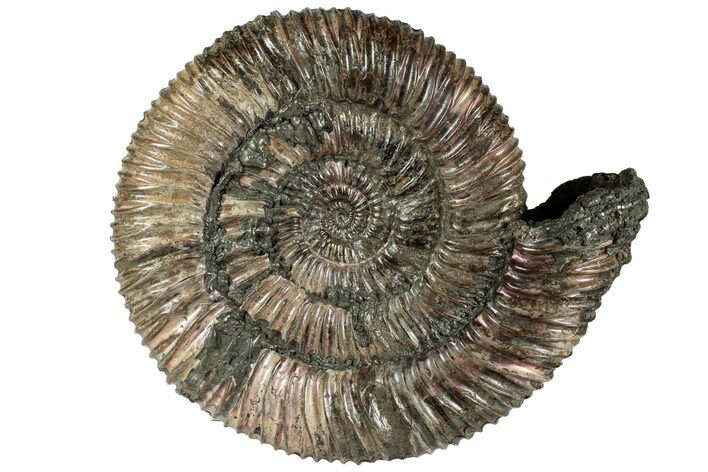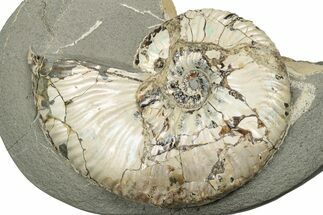This Specimen has been sold.
11.8" Iridescent, Pyritized Ammonite (Speetoniceras) Fossil
This is a large, 11.8" wide Speetoniceras versicolor ammonite fossil from the Lower Cretaceous (Hauterivian Stage) deposits of the Volga River in Russia. The preserved shell features a gorgeous red and purple iridescence that flashes in the light. Much of the pyrite that surrounded this ammonite has been left over its exterior, primarily along one side. This is a gorgeous display piece and it comes with a stand to facilitate aesthetic presentation.
There has been some restoration and repair to the ammonite. Several cracks have been repaired and filled on both sides of the ammonite and it's likely some of the pyrite has been added.
There has been some restoration and repair to the ammonite. Several cracks have been repaired and filled on both sides of the ammonite and it's likely some of the pyrite has been added.
About Ammonites
Ammonites were ancient marine cephalopods, similar to today's squids and octopuses, but with a defining feature: their distinctive, tightly coiled spiral shells. These shells, resembling those of modern nautiluses, served as both a protective home and a buoyancy aid, allowing ammonites to navigate the prehistoric seas with ease. First emerging around 240 million years ago in the Triassic Period, ammonites thrived for over 175 million years, adapting through numerous forms and sizes. As predatory creatures, they likely fed on smaller marine organisms, using their tentacles to capture prey. However, their long reign came to an end 65 million years ago at the close of the Cretaceous, coinciding with the mass extinction event that also eliminated the dinosaurs.
Ammonites were ancient marine cephalopods, similar to today's squids and octopuses, but with a defining feature: their distinctive, tightly coiled spiral shells. These shells, resembling those of modern nautiluses, served as both a protective home and a buoyancy aid, allowing ammonites to navigate the prehistoric seas with ease. First emerging around 240 million years ago in the Triassic Period, ammonites thrived for over 175 million years, adapting through numerous forms and sizes. As predatory creatures, they likely fed on smaller marine organisms, using their tentacles to capture prey. However, their long reign came to an end 65 million years ago at the close of the Cretaceous, coinciding with the mass extinction event that also eliminated the dinosaurs.
SPECIES
Speetoniceras versicolor
LOCATION
Volga river, Ulyanovsk region, Russia
SIZE
Ammonite: 11.8" wide
CATEGORY
SUB CATEGORY
ITEM
#228075
We guarantee the authenticity of all of our specimens.
 Reviews
Reviews













